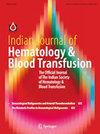The utility of quantitative D-Dimer assay as a biomarker in the diagnosis and exclusion of Cerebral Venous Sinus Thrombosis
IF 0.6
4区 医学
Q4 HEMATOLOGY
Indian Journal of Hematology and Blood Transfusion
Pub Date : 2022-12-22
DOI:10.1101/2022.12.21.22283814
引用次数: 0
Abstract
Thrombotic disorders are characterized by the presence of elevated levels of detectable fibrin degradation products in the blood. The utility and sensitivity of quantitative D-Dimer assay to rule out the diagnosis of deep vein thrombosis is well established. We extrapolated this principle to evaluate the utility of D-Dimer assay in exclusion of cerebral venous sinus thrombosis (CVST). CVST is an important cause of cerebrovascular accidents in young patients and the residual neurological deficits can be minimized if correct therapy, i.e., anticoagulation is instituted in a timely manner. As advanced imaging modalities that are required for the diagnosis of CVST might not be readily available everywhere, it is important to have a sensitive biomarker which can guide clinicians to rule out the diagnosis with a reasonable confidence. We evaluated the patients admitted at a tertiary care center who underwent Computed tomography (CT) Venography/Magnetic resonance (MR) Venography of the brain with the clinical suspicion of CVST. After appropriate exclusion, a quantitative D-Dimer assay was performed in patients who had CVST on CT/MR Venography and was compared with those patients who did not. Receiver operating characteristic (ROC) analysis revealed that quantitative D Dimer had poor diagnostic accuracy for the differentiation of CVST from non CVST cases (Area under the curve = 0.694), but D-Dimer levels of <300 ng/mL had a sensitivity of 90% for ruling out the diagnosis of CVST.定量d -二聚体测定在脑静脉窦血栓形成诊断和排除中的应用
血栓性疾病的特点是血液中可检测到的纤维蛋白降解产物水平升高。定量d -二聚体测定排除深静脉血栓诊断的实用性和敏感性已得到充分证实。我们推断这一原则来评估d -二聚体测定在排除脑静脉窦血栓形成(CVST)方面的效用。CVST是年轻患者发生脑血管意外的重要原因,如果及时进行正确的治疗,如抗凝治疗,可以减少残余的神经功能缺损。由于诊断CVST所需的先进成像模式可能并非随处可见,因此有一种敏感的生物标志物可以指导临床医生以合理的信心排除诊断是很重要的。我们评估了在三级保健中心接受计算机断层扫描(CT)静脉造影/磁共振(MR)静脉造影的临床怀疑为CVST的患者。在适当的排除后,对CT/MR静脉造影有CVST的患者进行定量d -二聚体测定,并与没有CVST的患者进行比较。受试者工作特征(ROC)分析显示,定量D-二聚体对CVST与非CVST的鉴别诊断准确性较差(曲线下面积= 0.694),但D-二聚体水平<300 ng/mL对排除CVST诊断的敏感性为90%。
本文章由计算机程序翻译,如有差异,请以英文原文为准。
求助全文
约1分钟内获得全文
求助全文
来源期刊
CiteScore
1.70
自引率
0.00%
发文量
82
审稿时长
>12 weeks
期刊介绍:
Indian Journal of Hematology and Blood Transfusion is a medium for propagating and exchanging ideas within the medical community. It publishes peer-reviewed articles on a variety of aspects of clinical hematology, laboratory hematology and hemato-oncology. The journal exists to encourage scientific investigation in the study of blood in health and in disease; to promote and foster the exchange and diffusion of knowledge relating to blood and blood-forming tissues; and to provide a forum for discussion of hematological subjects on a national scale.
The Journal is the official publication of The Indian Society of Hematology & Blood Transfusion.

 求助内容:
求助内容: 应助结果提醒方式:
应助结果提醒方式:


